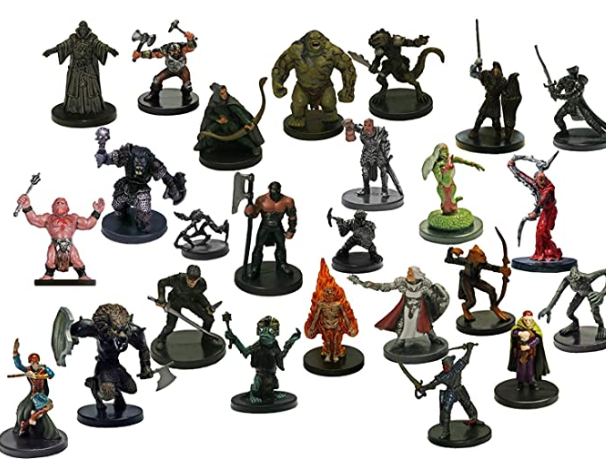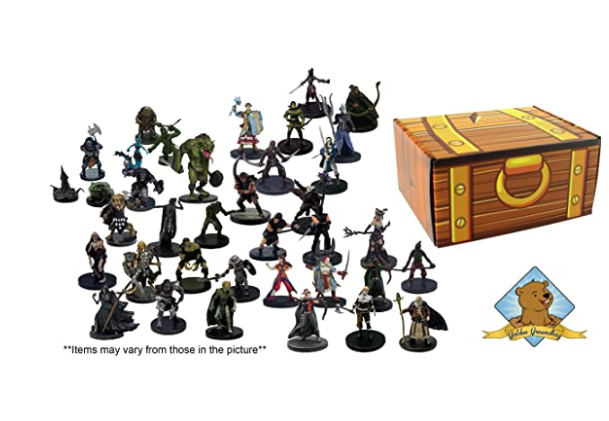The Dungeons & Dragons Miniatures Game, commonly mentioned as DDM, served as Wizards of the Coast’s official line of miniature figures for the Dungeons & Dragons game, following the cancellation of the previous Dungeons & Dragons-based miniatures game. This set was available in both Starter Sets, containing 16 random miniatures, a 20-sided die, a rulebook and maps, and terrain to play the game on, also as Booster Packs with 8 random miniatures. Each miniature also came with a card that detailed the statistics of the figure for the miniatures game on one side, and therefore the statistics to be used within the role-playing game on the other side.
Miniatures are a fun part of any tabletop roleplaying or wargame, and D&D minis have an upscale history. Following on from part where we explored absolutely the minimum you would like to urge started with Dungeons and Dragons, during this part we’ll explore the way to start with D&D miniatures.
While Dungeons and Dragons are famous for incorporating imagination into the mechanics, often mentioned as “theatre of the mind“, you would possibly be surprised to find out that miniatures were a part of the sport from the very beginning.
Table of Contents
D&D Miniatures
First of all, it helps visualize the state of play and contextualizes the weather in an encounter. this is often especially useful in combat (the traditional purpose), where distances and lines of sight are often critical for tactics, but also puzzles and dungeons, where placement and relationships between objects are often the difference between success and failure.
Dungeons and Dragons 25 Assorted D&d Miniatures Figures
- Product Dimensions: 6.3 x 5.39 x 4.8 inches
- Item Weight: 8.8 ounces
- ASIN: B000WD41RS
- UNSPSC Code: 60140000
- Manufacturer recommended age: 8 years and up
- Customer Reviews: 3.4 out of 5 stars 88 ratings
- Ratings: 3.4 out of 5 stars
- Is Discontinued By Manufacturer: No
- Mfg Recommended: age 8 years and up
- Manufacturer: Generic
Dungeons and Dragons 25 Assorted D&D Miniatures Figures! All Creatures! Comes in Golden Groundhog Treasure Chest Storage Box!
Secondly, it’s fun. The painting of miniatures has long been an enormous a part of the hobby, and actually, there are an excellent many of us who collect and paint minis exclusively, they don’t play the games in the least . also like painting, there are tons of individuals who are even more creative with their minis, sculpting, casting, customizing, and “kit-bashing” (taking parts from other models and mixing them into new creations), and last 3D-printing, which we’ll explore later.
Where it’s really at for getting the right representation of your character, however, is 3D printing. employing a system like Heroforge you’ll build an absolutely unique miniature that’s precisely how you would like your character to seem, right right down to their heroic pose and accessories.
Unlike Dungeons & Dragons, which like most role-playing games has players playing a part of one character, the Dungeons & Dragons Miniatures Game may be a miniatures wargame during which two opponents pit armies of creatures against one another. So as to permit rule adjudication without a Dungeon Master, the DDM rules are a streamlined sort of the d20 system, with a couple of additional features unique to the skirmish game. The game has skilled several revisions since the first Harbinger rules set, including revisions after Aberrations and Wardrums. The game was updated to be according to the fourth edition Dungeons & Dragons rules.
Each creature features a designated point cost, and players assemble a Warband of a particular cost, generally either 100, 200, or 500 points, counting on the tournament format. From Harbinger to Underdark, games were played on tiles arranged on a grid, while from War Drums onward, full-color printed battle maps were used. Players use a 20-sided die to work out if an attack succeeds and also for various other checks throughout the sport. Victory goes to the player who first accumulates a given number of points by either destroying the opponent’s figures or collecting points by occupying certain areas of the map.
While there are all types of miniatures out there, in D&D we tend to stay to 28mm scale (for human-sized characters, measured from feet to eyes), and infrequently 32mm. Of course, your halflings are going to be smaller and your giants are going to be much larger! this suggests your minis could be extremely mini, so you’ll want details to point out up and you’ll need fine brushes.
In terms of fabric, historically the miniatures were metal (pewter hopefully instead of lead), but it’s more likely now that your miniatures are going to be resin or plastic, as technologies improved, and for cost-savings. Your paints will be got to adhere well to those materials, and not peel or chip easily.
For paints, you are going for acrylic modeling paints. While many cheap craft paints will work, and for priming, you’ll often escape with generic primer out of a rattle can, if you’re just getting started you’ll not want to frustrate yourself with bad materials and fight against peeling, globby, paint coverage.
D&D miniatures are supported characters and monsters portrayed in Dungeons and Dragons. the size they follow is in accordance with how they measure compared to the human form on the metric scale.
Miniatures utilized in tabletop wargaming are categorized by scale. The size is employed to live a miniature either by how it compares to the real-life object it represents or to human form.
The point that the designer chooses because the top height at which to start out measuring the miniature is usually mentioned because of the “reference point.” The point of reference may be:
- The absolute top of the miniature including hats, helmets, etc.
- The top of the top, not including headgear.
- The eyes.
The proportion in miniatures refers to what proportion they compare in proportion to the first model they represent. Proportions in miniatures are separated into realistic and heroic. Both determine how closely the looks and size of the miniature compare to the figure it had been modeled after.
Most scales of miniatures range from 15mm to 28mm, but it’s important to require into consideration that certain miniature scales vary counting on their designer, and therefore the Kelvin scale wont to measure them.
These miniatures are 28 mm scale, ready for play straight out of the box, and are available with fantastic reviews.
For those of you preferring to custom paint your own miniatures and are trying to find a much bigger boost to kick-start your epic campaign at a reasonable price, try Newcombie’s 28 mm miniatures pack of 18.
Path Gaming offers a good larger option with their 28 mm pack of 38, but if you’re really looking to travel all-out, this pack of 56 by Monster is tough to beat.
If you’re curious about learning more about painting D&D miniatures, make certain to see out my article on recommended miniature painting tools.

